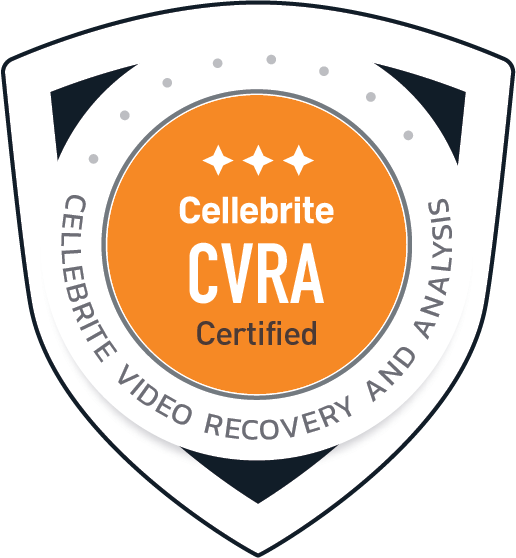Cellebrite Video Recovery and Analysis Course (CVRA)

5 days
Intermediate-level course
Course Description
Cellebrite Video Recovery and Analysis (CVRA) is a five (5) day intermediate level course designed to introduce investigators, examiners, and analysts to digital video technology and to meet the specific needs of the digital video examiner and analyst. Students will learn proper methods to interrogate digital video evidence devices while receiving guided instruction throughout the process of recovering valuable evidence from video images.
CVRA instruction will also focus on specialized investigative techniques for the examination of video to explore issues relating to the use of force, speed estimation and identification. A variety of DVR, body-worn and in-car video sources will be examined in depth, testing data acquisition, file identification, image accuracy, video processing workflows and report writing.
CVRA instruction will also focus on specialized investigative techniques for the examination of video to explore issues relating to the use of force, speed estimation and identification. A variety of DVR, body-worn and in-car video sources will be examined in depth, testing data acquisition, file identification, image accuracy, video processing workflows and report writing.
The course will provide students with an understanding of best practices and methodologies for extracting and examining digital media evidence while providing students with focused, practical use of DVR Examiner and iNPUT-ACE. Upon successful completion of the course, students will be offered an opportunity to take an industry-recognized certification examination, created in partnership with DME Forensics and iNPUT-ACE.
Course Content

Basic Technical Overview
- Digital Video Terminology
- Digital Video Definitions
- Digital Video Technology

Traditional DVR Acquisition and Recovery
- Traditional acquisition methods
- USB Export
- DVR Interface
- Cloning
- Analog output
- Screen Recording

Traditional Playback and Processing of Digital Video Evidence
- Proprietary players
- Screen Captures
- Transcoding vs. Rewrapping
- Codecs

Simplified Acquisition of Digital Video Evidence
- DVR Examiner Hands-On Overview
- Basic Walkthrough of the DVR Examiner User Interface
- Demonstration of the “easy and better way” to acquire digital video evidence

Simplified Processing of Digital Video Evidence
- iNPUT-ACE Hands-On Overview
- Basic Walkthrough of the iNPUT-ACE User Interface
- Demonstration of the “easy and better way” to process and analyze digital video evidence

Legal and Evidentiary Considerations
- Best Practices
- Federal Rules of Evidence, Chain of Custody and Evidence Integrity
- Consent, Warrants and Seizure
- Demonstrate the hands-on use of DVE Examiner and iNPUT-ACE

Acquisition Best Practices
- Bag and Tag
- Date/Time Offsets and Logging Serial Numbers
- Contacting Owner for Information
- Use of Write-Blockers
- Imaging and Hands-on Hashing
- DVR Disassembly

DVR Examiner Overview
- DVR Examiner in Depth
- DVR File Structures
- Date/Time Filtering
- Inaccessible Data
- Extracting Video Clips and Saving Projects

Building Projects with iNPUT-ACE
- Focused hands-on instruction on the use of iNPUT-ACE to build projects
- Organizing File List / Projects
- Marking / Grouping Images
- Saving / Reloading Projects

Technical Considerations Processing Digital Video
- Infrared Considerations
- Interlacing
- Aspect Ratio
- Refresh Rates
- Frame Hashing / Rewrapping

Video Compression Overview
- Spatial Compression
- Temporal Compression
- Macroblock Analysis
- Video

Building Narrative Reports with iNPUT-ACE
- Building a Narrative Report
- Creating Demonstrative Exhibits
- Sub-Clip Concatenation
- Working with a Case
- Reporting

Hands-On Practical Acquisition
- Students are provided with a scenario
- Students use practical skills learned to acquire digital video from several digital video sources

Hands-On Practical Processing and Reporting
- Students will build upon digital video acquired during the acquisition hands-on practical exercise
- Students will apply techniques learned and process the mock-scene video
- Students will prepare a report on their findings
Last modified: Tuesday, January 18, 2022, 7:09 AM
